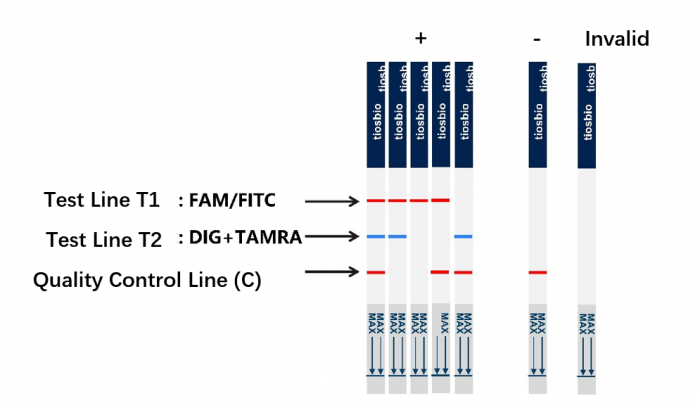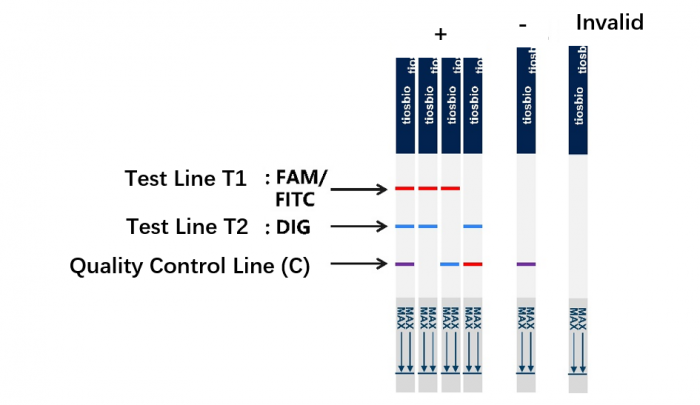- 宝盈同汇网站产品目录更新中
- 131 2661 6699
- 187 0140 6699
- biowinner@163.com
Tiosbio’s two new CRISPR dual-target nucleic acid detection test strips are coming
Tiosbio’s two new CRISPR dual-target nucleic acid detection test strips are coming
Editor’s Choice:
Tiosbio focuses on “technological innovation + advanced manufacturing” of in vitro diagnostic nucleic acid detection test strip products, and has launched two new CRISPR Cas-based dual-target nucleic acid detection test strips.
The new crown epidemic has not yet faded, and the monkeypox virus has followed suit. With the needs of virus detection in different application scenarios, CRISPR molecular diagnostic technology can be efficiently docked with various nucleic acid amplification methods such as PCR, LAMP and RPA/RAA, and has the advantages of rapid and accurate identification of pathogens. Rapid rise in real-time detection technology, and become one of the booming directions in scientific research and IVD industry.
At present, the widely commercialized CRISPR nucleic acid detection test strips on the market can only display the cleavage product of a single reporter molecule. Therefore, although a large number of heavy-weight research results have been formed in the scientific research field, it is still difficult to meet the IVD industry’s demand for detection of double target in the same sample. Therefore, it has not been widely used.
Tiosbio focuses on “technological innovation + advanced manufacturing” of in vitro diagnostic nucleic acid detection test strip products, and has launched two new products of dual-target nucleic acid detection test strips based on CRISPR Cas:
-
Amplified product and Cas digestion product detection test strip (JY0307)
JY0307 is suitable for IVD pathogen rapid detection kit. The quality control of the internal reference gene is displayed by the detection line T2 of the double-stranded amplification product to monitor whether the nucleic acid release and amplification steps in the detection process are working normally; The signal amplification process of the target gene by the detection line T1 of the cleavage product of the CRISPR signal probe ensures the detection of the target gene with high specificity and high sensitivity.
When the CRISPR signal probe (detection line T1) and the double-stranded amplification product (detection line T2) are modified as follows, JY0307 can be used for detection—one end of the CRISPR signal probe is modified with biotin (Biotin), and the other end Modified with fluorescein isothiocyanate (FITC) or 6-carboxyfluorescein (6-FAM); one end of the amplification product is modified with digoxin (Dig), and the other end is modified with rhodamine (TAMRA).
The interpretation of the color development results of different detection lines and quality control lines of JY0307 is shown in the figure below.

The interpretation of the color development results of different detection lines and quality control lines of JY0307
-
Cas12/Cas13 double enzyme digestion product detection test strip (JY0308)
JY0308 is suitable for the detection of double-stranded products after Cas12 and Cas13 double enzyme digestion in the same system. After the target gene is amplified by PCR, LAMP, RPA/RAA, in the same system, Cas12 and Cas13 enzymes are used to simultaneously cut the amplified product, and the DNA signal probe A (Cas12 cutting) corresponding to the Cas12 enzyme; the RNA signal probe B (Cas13 cleavage) corresponding to the Cas13 enzyme can be modified as follows, and then JY0308 can be used to detect the cleavage product – wherein, one end of the DNA signal probe A is modified with biotin (Biotin), and the other end is modified with iso Fluorescein thiocyanate (FITC) or 6-carboxyfluorescein (6-FAM), one end of RNA signal probe B is modified with biotin (Biotin), the other end is modified with digoxin (Dig); or DNA signal probe A is modified with biotin at one end and digoxin (Dig) at the other end, and RNA signal probe B is modified with biotin at one end and fluorescein isothiocyanate at the other end (FITC) or 6-carboxyfluorescein (6-FAM).
The special feature of JY0308 is that the product is a color-changing double-correction color test strip. When both the DNA signal probe A and the RNA signal probe B undergo enzyme cleavage reactions, but the enzyme cleavage reactions are incomplete, the quality control line C, detection line T1 and detection line T2 will all develop color, and the quality control line C It is purple, the detection line T1 is red, and the detection line T2 is blue; when DNA signal probe A and RNA signal probe B are completely digested, only detection line T1 and detection line T2 develop color, and T1 is red , T2 is blue. When Probe A and Probe B are mixed at equimolar concentrations and the final concentration is ≤500nM, the FAM-labeled probe undergoes an enzyme cleavage reaction, but when the Dig-labeled probe is not digested, there is only a detection line T1 is red, and the quality control line C is blue; when the Dig-labeled probe undergoes an enzyme digestion reaction, but the FAM-labeled probe is not digested, only the detection line T2 is blue, and the quality control line is blue. C is red, so as to achieve the purpose of mutual correction.
The interpretation of the color development results of different detection lines and quality control lines of JY0308 is shown in the figure below.

The interpretation of the color development results of different detection lines and quality control lines of JY0308

